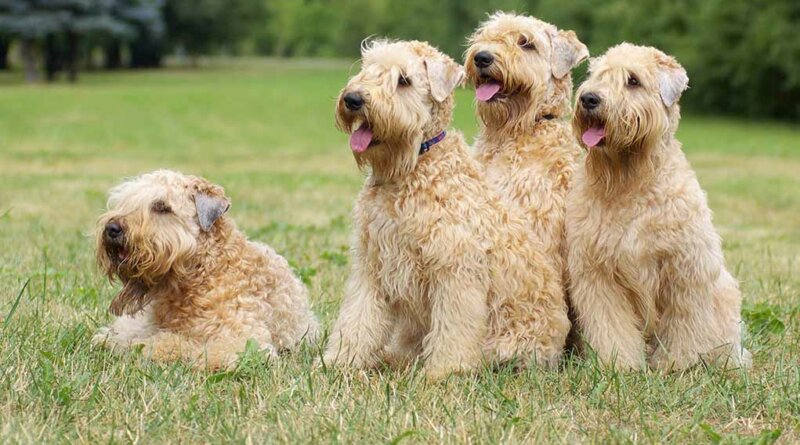Soft Coated Wheaten Terrier
As a pure-bred terrier, the soft coated wheaten terrier originated in Ireland. It will typically have two coats: the heavy coat (American) or the Irish coat. When compared, the American coat is often fuller and thicker than the Irish coat.
The Irish coat is typically wavier and thicker. The Wheaten personality is a friendly and playful pup; it gets along with other animals and children.
The History of the Soft-Coated Wheaten Terrier
Bred initially as a farm dog in Ireland over two hundred years ago, the Wheaten thrives on watching and guarding livestock, hunting and killing livestock, and herding. Wheaten Terriers were called affectionately “Poor Man’s Wolfhound.”
To avoid paying taxes, the dog’s tails were docked, and they were restricted to specific sizes (as a docked tail signified that the dog was a working dog).
This breed has been around for at least two hundred years. But it wasn’t recognized by the Irish Kennel Club until 1937, and 1943 by the British Kennel Club finally recognized the breed within the United Kingdom.
Wheatens were first exported in the 1940s. The breed’s popularity didn’t peak until the 1950s. The Soft Coated Wheaten Terrier Club of America, Inc. was established in 1962.
Seven years later, The Soft Coated Wheaten Terrier Club of Great Britain was established. And in 1973, the Wheaten Terrier was recognized by the American Kennel Club.
The Soft Coated Wheaten Terrier Club of America helps to advance the breed’s interests. It also guards against commercial exploitation. And it serves prospective owners, competition organizers, and breeders of this breed.
 Physical Appearance of the Soft-Coated Wheaten Terrier
Physical Appearance of the Soft-Coated Wheaten Terrier
One of the most notable features of the soft coated wheaten terrier is its beautiful, silky single coat. The coat will cover his entire body in gentle waves, giving him a unique appearance different from the rest of the terrier family.
As the name suggests, this breed will have a range of “wheaten” colors, from pale beige to bright, shimmering gold. These dogs may occasionally have random black, white, or red hair throughout their coat.
All soft-coated wheaten terriers are born with dark coats that lighten with age, often changing from straight to wavy until they’re two years old.
The Soft-Coated Wheaten Terrier has a single coat that falls in gentle waves over his body, including covering his eyes. This breed lacks an undercoat as a single coat, meaning it sheds substantially less than other breeds.
Hypoallergenic, maybe?
Typically touted as hypoallergenic, the Soft-Coated Wheaten Terrier has less pet dander than those breeds with an undercoat. It’s important to remember that all dogs, including this breed, produce small amounts of pet dander.
While this may not be enough to trigger allergies, it’s important to remember that every breed does have dander.
Grooming
These dogs will stand at 17-19 inches tall and will weigh between 30-40 pounds as adults. Grooming this breed can be substantial, depending on the type of look you prefer. If you’re hoping to achieve a soft and silky coat, you’ll need to brush and detangle your pup daily.
A quick 15-minute grooming session a few times a week is sufficient for those wanting a rougher or scruffy look. You’ll likely want to use a de-matting comb and a slicker brush for grooming.
If you’re hoping to trim the dog’s fur, you’ll want a high-quality pair of scissors too. This dog isn’t great for germaphobes; his coat attracts debris, snow, and dirt. He is known for wiping his mouth on couches or legs after he’s eaten too.
Always start grooming your puppy at a young age to get him used to handle and desensitization. Some dogs can be susceptible to having their feet touched, which makes handling that much more important, especially for trimming their nails.
Start with small, positive experiences instead of potentially traumatic events. This desensitization also becomes essential when dealing with groomers and veterinarians.
 Best Home Environments for the Soft Coated Wheaten Terrier
Best Home Environments for the Soft Coated Wheaten Terrier
This breed is perfect at adapting to new environments, from large open spaces to living in an apartment building. The trick to his living quarters isn’t the unit’s size; it’s the amount of exercise you provide.
This breed enjoys the company of humans and doesn’t do well with staying outdoors or away from the family unit for extended periods.
Ensure that you provide at least 30 minutes of physical activity each day, whether through walks, runs, playing fetch, or enjoying a few sporting drills.
It’s important to remember that this dog shouldn’t be left unattended, especially in an insecure backyard. A terrier has a very high prey drive; it can chase small animals if not confined.
Although electric fences sound good in theory, it is often not strong enough to deter a terrier from chasing prey.
The soft coated wheaten terrier does well with early training sessions; he’s a determined dog with a mind and opinion of his own.
If involved in obedience training at an early age, the Wheaten terrier will thrive with positive reinforcement.
 General Personality Traits of The Wheaten Terrier
General Personality Traits of The Wheaten Terrier
This alert and happy pup is a steady and self-confident pup with an excellent demeanor. Although this breed has the capacity to be an excellent watchdog, his friendly personality makes him far too friendly to act on anything concerning.
The soft coated wheaten terriers need early socialization, with exposure to many people, sounds, experiences, and sights. They generally love children and get along well with other animals.
This becomes particularly significant when the dog has been raised with the animal in question. It’s important to note that any terrier will chase a small, furry creature – especially outside.
The Wheaten can be quite headstrong; they may become difficult to train but will respond well to positive reinforcement.
Social Animals
These dogs are pretty social with other dogs and humans, remaining affectionate and loving with almost everyone they meet. The Soft Coated Wheaten Terrier is a choice for both experienced dog owners and first-time pet parents.
They are adaptable pups that can work with elderly parents, young families with children, busy homes, or quiet solitudes.
Owners of the Soft Coated Wheaten Terrier are often surprised to find how high-maintenance the coats can be, particularly if you’d like the soft, wavy appearance.
Although they’re not high-energy dogs, they do require some physical activity throughout the day. They have been involved with agility, sports competitions, training, and other therapy-type programs.
The Soft Coated Wheaten Terrier doesn’t do well alone, becoming more prone to worry or anxiety when left alone.
Wheaten Terriers Don’t Prefer The Cold.
They often struggle with cold weather conditions due to the single coat status. It’s essential to have a sweater or coat available when walking throughout the winter months, especially in climates with snow or freezing rain.
They don’t necessarily shed a lot due to their top-flowing coat. These dogs have been known to be on the messy side. Their fur attracts both water and snow outside.
Don’t be surprised if you happen to find snowballs throughout your home after a walk through the park on a snowy afternoon.
While these dogs aren’t happy, they will bark when someone approaches the home.
They don’t howl or bark a lot but can be a bit mouthy when the situation is something they disagree with (for example, when trying to enforce training exercises).
Common Health Concerns for the Wheaten Terrier Breed
One of the easiest ways to limit the potential likelihood of ongoing health concerns is to source your soft coated wheaten terrier from a reputable, licensed breeder or rescue organization.
While not all Wheaten dogs will get all (or any) of these diseases, having a solid understanding of what to watch for is essential.
Addison’s Disease
Formally known as hypoadrenocorticism, this severe condition is caused by insufficient production of adrenal hormones. If you suspect your dog is suffering from this condition, they would likely have a poor appetite, vomiting, and little energy.
Unfortunately, symptoms are pretty vague and are easily mistaken for other medical conditions. That makes it more likely to be diagnosed in advanced stages.
Severe stages typically occur when potassium levels become so elevated that they interfere with the dog’s heart function, causing shock and death.
If your veterinarian suspects your dog is suffering from Addison’s disease, they may order subsequent tests to confirm the diagnosis.
Renal Dysplasia (RD)
This condition will typically call renal failure, caused by abnormal development of the kidney. Unfortunately, the Soft Coated Wheaten Terrier is known for inherited renal dysplasia.
Symptoms of this condition will often include poor appetite, vomiting, increased water consumption, and frequent urinary tract infections.
These symptoms can often be mistaken for other medical conditions, but a veterinarian will suggest additional tests and procedures confirm the diagnosis.
Protein-Losing Enteropathy (PLE)
Characterized by the excessive loss of proteins and plasma through the gastrointestinal tract. There is no cure currently for PLE.
It presents as symptoms of weight loss, diarrhea, increased thirst, increased breathing, swelling of the abdomen or legs, and labored breathing. You can manage this condition with diet and medication.
Protein-Losing Nephropathy
This condition is the excessive amount of plasma and proteins lost through the kidney. There is no cure for this condition, but you can manage nephropathy through diet and medications.
Many times, dogs dealing with protein-losing nephropathy will have an increase in serum creatinine and urea nitrogen. They will also suffer from increased phosphorus, high levels of anemia, and high cholesterol.
Symptoms will include swelling of the abdomen and legs, increased thirst and urination, labored breathing, weight loss, and kidney failure.
It’s important to have any of the previous symptoms above evaluated by the veterinarian. These symptoms can be from another condition. You can mitigate many problems. They can also be made less problematic through diet, medications, and ongoing monitoring.
If you’ve noticed a sudden increase in your dog’s symptoms, always contact your vet immediately for a consultation.
Choosing A Reputable Soft Coated Wheaten Terrier Breeder
Choosing a reputable breeder is crucial in getting a healthy and well-tempered pet. You’ll want to investigate any breeder selling the soft coated wheaten terrier, mainly if they are selling them online.
Ask whether both parents are available for viewing and specific questions about the parents’ physical attributes and personality traits.
Many reputable breeders will charge for a deposit, but it’s always a wise decision to see the dogs (parents and puppies) in person before leaving a deposit. Likewise, it’s always a bright idea to get a contract in writing before giving any money to the breeder.
Some high-quality breeders may have a waitlist for future litters. These will always have a conditional agreement, depending on how many deposits they have available.
If purchasing a puppy from a breeder, ask them about any terms or conditions they have for their puppies. Some breeders will offer a health guarantee on the dogs, especially regarding any of these common conditions.
They may require a diagnosis from your vet, or they may require you to attend their local vet to confirm the diagnosis. You should check if your breeder offers a health guarantee. Know what terms and conditions are for this guarantee.
A good breeder will exchange the dog for another pup. If you have become attached to the puppy, this may be a difficult exchange.
It would help if you asked your Soft Coat Wheaten Terrier breeder whether they require their pups to be altered after purchase. For many wanting to show or breed the dog, there may be additional fees or costs with the breeder.
This extra fee condition is particularly true if the dame or sire has had a history of showing well.
Final Thoughts: Avoid The Puppy Mill
If you are looking at purchasing your pup or dog from a retail store, always make sure to ask about lineage and where they find the dogs for sale. Pet stores have been known to purchase puppies from “puppy mills.”
These mills are large breeding organizations, taking profit and production over the living conditions of the dogs. If a pet store cannot confirm where they acquired the dogs, it’s best to pass on the purchase.



 Physical Appearance of the Soft-Coated Wheaten Terrier
Physical Appearance of the Soft-Coated Wheaten Terrier Best Home Environments for the Soft Coated Wheaten Terrier
Best Home Environments for the Soft Coated Wheaten Terrier General Personality Traits of The Wheaten Terrier
General Personality Traits of The Wheaten Terrier
